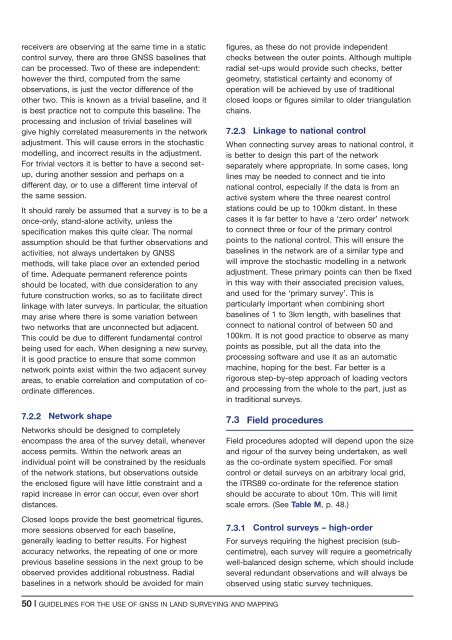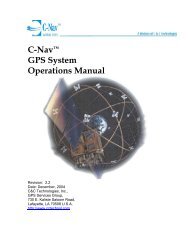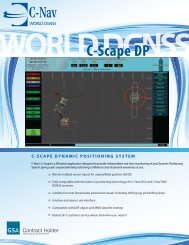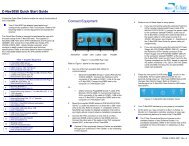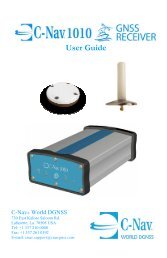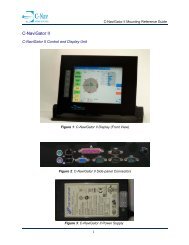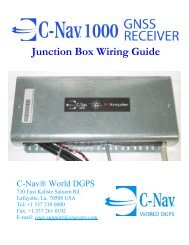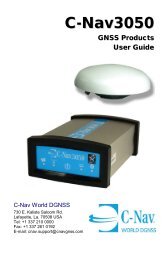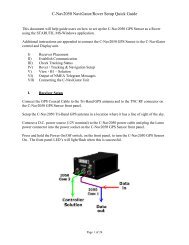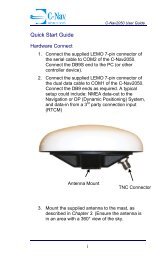Guidelines for the use of GNSS in surveying and mapping
Guidelines for the use of GNSS in surveying and mapping
Guidelines for the use of GNSS in surveying and mapping
Create successful ePaper yourself
Turn your PDF publications into a flip-book with our unique Google optimized e-Paper software.
eceivers are observ<strong>in</strong>g at <strong>the</strong> same time <strong>in</strong> a static<br />
control survey, <strong>the</strong>re are three <strong>GNSS</strong> basel<strong>in</strong>es that<br />
can be processed. Two <strong>of</strong> <strong>the</strong>se are <strong>in</strong>dependent:<br />
however <strong>the</strong> third, computed from <strong>the</strong> same<br />
observations, is just <strong>the</strong> vector difference <strong>of</strong> <strong>the</strong><br />
o<strong>the</strong>r two. This is known as a trivial basel<strong>in</strong>e, <strong>and</strong> it<br />
is best practice not to compute this basel<strong>in</strong>e. The<br />
process<strong>in</strong>g <strong>and</strong> <strong>in</strong>clusion <strong>of</strong> trivial basel<strong>in</strong>es will<br />
give highly correlated measurements <strong>in</strong> <strong>the</strong> network<br />
adjustment. This will ca<strong>use</strong> errors <strong>in</strong> <strong>the</strong> stochastic<br />
modell<strong>in</strong>g, <strong>and</strong> <strong>in</strong>correct results <strong>in</strong> <strong>the</strong> adjustment.<br />
For trivial vectors it is better to have a second setup,<br />
dur<strong>in</strong>g ano<strong>the</strong>r session <strong>and</strong> perhaps on a<br />
different day, or to <strong>use</strong> a different time <strong>in</strong>terval <strong>of</strong><br />
<strong>the</strong> same session.<br />
It should rarely be assumed that a survey is to be a<br />
once-only, st<strong>and</strong>-alone activity, unless <strong>the</strong><br />
specification makes this quite clear. The normal<br />
assumption should be that fur<strong>the</strong>r observations <strong>and</strong><br />
activities, not always undertaken by <strong>GNSS</strong><br />
methods, will take place over an extended period<br />
<strong>of</strong> time. Adequate permanent reference po<strong>in</strong>ts<br />
should be located, with due consideration to any<br />
future construction works, so as to facilitate direct<br />
l<strong>in</strong>kage with later surveys. In particular, <strong>the</strong> situation<br />
may arise where <strong>the</strong>re is some variation between<br />
two networks that are unconnected but adjacent.<br />
This could be due to different fundamental control<br />
be<strong>in</strong>g <strong>use</strong>d <strong>for</strong> each. When design<strong>in</strong>g a new survey,<br />
it is good practice to ensure that some common<br />
network po<strong>in</strong>ts exist with<strong>in</strong> <strong>the</strong> two adjacent survey<br />
areas, to enable correlation <strong>and</strong> computation <strong>of</strong> coord<strong>in</strong>ate<br />
differences.<br />
7.2.2 Network shape<br />
Networks should be designed to completely<br />
encompass <strong>the</strong> area <strong>of</strong> <strong>the</strong> survey detail, whenever<br />
access permits. With<strong>in</strong> <strong>the</strong> network areas an<br />
<strong>in</strong>dividual po<strong>in</strong>t will be constra<strong>in</strong>ed by <strong>the</strong> residuals<br />
<strong>of</strong> <strong>the</strong> network stations, but observations outside<br />
<strong>the</strong> enclosed figure will have little constra<strong>in</strong>t <strong>and</strong> a<br />
rapid <strong>in</strong>crease <strong>in</strong> error can occur, even over short<br />
distances.<br />
Closed loops provide <strong>the</strong> best geometrical figures,<br />
more sessions observed <strong>for</strong> each basel<strong>in</strong>e,<br />
generally lead<strong>in</strong>g to better results. For highest<br />
accuracy networks, <strong>the</strong> repeat<strong>in</strong>g <strong>of</strong> one or more<br />
previous basel<strong>in</strong>e sessions <strong>in</strong> <strong>the</strong> next group to be<br />
observed provides additional robustness. Radial<br />
basel<strong>in</strong>es <strong>in</strong> a network should be avoided <strong>for</strong> ma<strong>in</strong><br />
figures, as <strong>the</strong>se do not provide <strong>in</strong>dependent<br />
checks between <strong>the</strong> outer po<strong>in</strong>ts. Although multiple<br />
radial set-ups would provide such checks, better<br />
geometry, statistical certa<strong>in</strong>ty <strong>and</strong> economy <strong>of</strong><br />
operation will be achieved by <strong>use</strong> <strong>of</strong> traditional<br />
closed loops or figures similar to older triangulation<br />
cha<strong>in</strong>s.<br />
7.2.3 L<strong>in</strong>kage to national control<br />
When connect<strong>in</strong>g survey areas to national control, it<br />
is better to design this part <strong>of</strong> <strong>the</strong> network<br />
separately where appropriate. In some cases, long<br />
l<strong>in</strong>es may be needed to connect <strong>and</strong> tie <strong>in</strong>to<br />
national control, especially if <strong>the</strong> data is from an<br />
active system where <strong>the</strong> three nearest control<br />
stations could be up to 100km distant. In <strong>the</strong>se<br />
cases it is far better to have a ‘zero order’ network<br />
to connect three or four <strong>of</strong> <strong>the</strong> primary control<br />
po<strong>in</strong>ts to <strong>the</strong> national control. This will ensure <strong>the</strong><br />
basel<strong>in</strong>es <strong>in</strong> <strong>the</strong> network are <strong>of</strong> a similar type <strong>and</strong><br />
will improve <strong>the</strong> stochastic modell<strong>in</strong>g <strong>in</strong> a network<br />
adjustment. These primary po<strong>in</strong>ts can <strong>the</strong>n be fixed<br />
<strong>in</strong> this way with <strong>the</strong>ir associated precision values,<br />
<strong>and</strong> <strong>use</strong>d <strong>for</strong> <strong>the</strong> ‘primary survey’. This is<br />
particularly important when comb<strong>in</strong><strong>in</strong>g short<br />
basel<strong>in</strong>es <strong>of</strong> 1 to 3km length, with basel<strong>in</strong>es that<br />
connect to national control <strong>of</strong> between 50 <strong>and</strong><br />
100km. It is not good practice to observe as many<br />
po<strong>in</strong>ts as possible, put all <strong>the</strong> data <strong>in</strong>to <strong>the</strong><br />
process<strong>in</strong>g s<strong>of</strong>tware <strong>and</strong> <strong>use</strong> it as an automatic<br />
mach<strong>in</strong>e, hop<strong>in</strong>g <strong>for</strong> <strong>the</strong> best. Far better is a<br />
rigorous step-by-step approach <strong>of</strong> load<strong>in</strong>g vectors<br />
<strong>and</strong> process<strong>in</strong>g from <strong>the</strong> whole to <strong>the</strong> part, just as<br />
<strong>in</strong> traditional surveys.<br />
7.3 Field procedures<br />
Field procedures adopted will depend upon <strong>the</strong> size<br />
<strong>and</strong> rigour <strong>of</strong> <strong>the</strong> survey be<strong>in</strong>g undertaken, as well<br />
as <strong>the</strong> co-ord<strong>in</strong>ate system specified. For small<br />
control or detail surveys on an arbitrary local grid,<br />
<strong>the</strong> ITRS89 co-ord<strong>in</strong>ate <strong>for</strong> <strong>the</strong> reference station<br />
should be accurate to about 10m. This will limit<br />
scale errors. (See Table M, p. 48.)<br />
7.3.1 Control surveys – high-order<br />
For surveys requir<strong>in</strong>g <strong>the</strong> highest precision (subcentimetre),<br />
each survey will require a geometrically<br />
well-balanced design scheme, which should <strong>in</strong>clude<br />
several redundant observations <strong>and</strong> will always be<br />
observed us<strong>in</strong>g static survey techniques.<br />
50 | GUIDELINES FOR THE USE OF <strong>GNSS</strong> IN LAND SURVEYING AND MAPPING


